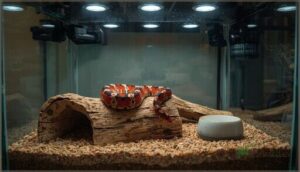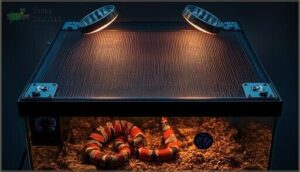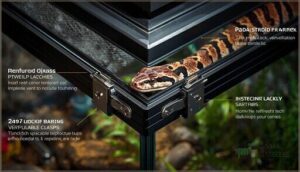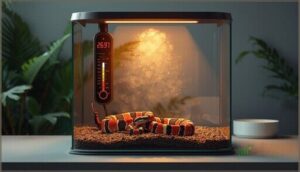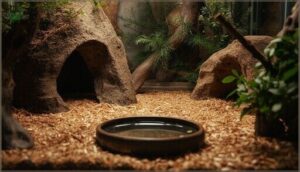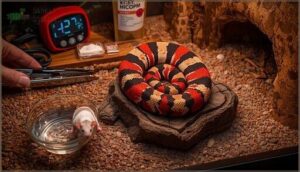This site is supported by our readers. We may earn a commission, at no cost to you, if you purchase through links.
You’ve just brought home a milk snake, and the excitement quickly shifts to questions. What temperature keeps it comfortable? How much space does it really need? Your new pet can’t tell you if something’s wrong, so getting the setup right from day one isn’t optional—it’s essential.
These docile constrictors adapt well to captivity, but they depend entirely on you to recreate the conditions that keep them healthy. A proper milk snake care sheet online bridges the gap between guesswork and confident ownership, giving you the exact parameters for enclosure size, heating zones, humidity levels, and feeding schedules.
With the right foundation, your milk snake won’t just survive—it’ll thrive for the next 15 to 20 years.
Table Of Contents
- Key Takeaways
- Milk Snake Species and Characteristics
- Choosing and Setting Up an Enclosure
- Temperature, Lighting, and Humidity Control
- Substrate, Decor, and Environmental Enrichment
- Feeding, Health, and Routine Care
- Frequently Asked Questions (FAQs)
- Are milk snakes easy to keep?
- How often should I feed a milk snake?
- What is the best bedding for milk snakes?
- How do you take care of a milk snake?
- How long do milk snakes typically live in captivity?
- Are milk snakes safe to keep around children?
- What are common color morphs of milk snakes?
- Can milk snakes be housed with other reptiles?
- How often do milk snakes shed their skin?
- Can milk snakes live with other reptiles?
- Conclusion
Key Takeaways
- Your milk snake’s enclosure must provide a precise thermal gradient between 70–75°F on the cool side and 85–88°F on the warm side, with humidity maintained at 40–60% year-round to prevent respiratory issues and shedding problems.
- Feeding schedules depend strictly on age—hatchlings need prey every 5 days, juveniles every 7–10 days, and adults every 10–14 days—with prey size matching the snake’s mid-body width to avoid health complications.
- Milk snakes are solitary animals that can’t be housed with other reptiles due to documented cannibalistic behavior and aggression rates reaching 35–40% in mixed enclosures.
- With proper husbandry including correct temperature, humidity, feeding protocols, and regular monitoring, your milk snake will thrive for 15–22 years in captivity, with some individuals reaching 27 years.
Milk Snake Species and Characteristics
Understanding what makes milk snakes unique starts with recognizing their diversity and physical traits. These snakes come in several subspecies, each with distinct color patterns that sometimes mimic venomous species.
Before you bring one home, you’ll want to know what to expect regarding size, lifespan, and behavior.
Common Milk Snake Subspecies
Milk snakes showcase striking diversity across 25 recognized subspecies.
The Eastern Milksnake features distinctive reddish blotches and a chequered belly, spanning from the Great Lakes to the Appalachians. The Honduran Milksnake stands out with its thick build and broad red bands, while Sinaloan Milksnakes display striking red, black, and yellow patterns. Mexican Milksnakes remain compact under 30 inches, and Pale Milksnakes feature dusty white backgrounds with minimal black rings.
Their bright colors are an example of aposematic mimicry.
Physical Appearance and Patterns
Beyond subspecies classification, you’ll notice impressive variation in scale morphology and color morphs across milk snake populations.
These smooth-scaled snakes display five key physical traits:
- Banded or blotched patterns in red, black, and yellow/white combinations
- Nineteen to twenty-three rows of unkeeled dorsal scales at midbody
- Checkerboard belly patterns (especially in Eastern subspecies)
- Single, undivided anal plate distinguishing them from similar species
- Light “Y” or “V” marking on the nape
Pattern development intensifies in hatchlings, then gradually dulls with age. Regional differences create diverse morphs, with banding mimicry protecting them through resemblance to venomous coral snakes. The Montana Field Guide provides information on species.
Lifespan and Adult Size
Your milk snake’s lifespan depends on captive care quality and subspecies. With proper husbandry, expect 15 to 22 years—some individuals reach 27. Wild lifespan averages 12 to 15 years due to predation.
With proper care, milk snakes live 15 to 22 years in captivity—some even reach 27
Hatchlings emerge at eight inches, while adults usually measure 24 to 48 inches, though certain subspecies exceed 84 inches. Weight variance ranges from 38 grams to 1,400 grams in large captive specimens.
Growth timeline spans three to four years until sexual maturity.
Temperament and Behavior
While size matters for housing, temperament shapes your daily interactions. Milk snakes are largely docile and non-aggressive, though juveniles show defensive behaviors—biting and tail-vibrating—in up to 40% of hatchlings. Regular, gentle handling reduces these reactions by over 50%. Adults tolerate three weekly sessions without chronic stress.
Key temperament traits include:
- Primarily nocturnal activity patterns, spending over 90% of time hidden
- Solitary nature except during communal brumation periods
- Defensive musk secretion occurs in 70% of threatened encounters
Handling techniques improve bite behavior and overall snake temperament. Environmental stress from frequent disturbances elevates corticosterone levels, so maintain stable routines. Well-acclimated individuals demonstrate excellent handling tolerance, making milk snake behavior predictable and manageable for dedicated keepers. Social interactions remain minimal outside breeding season.
Choosing and Setting Up an Enclosure
Setting up the right enclosure is your first step toward creating a safe, comfortable home for your milk snake. The enclosure you choose affects everything from temperature control to your snake’s overall health and behavior.
Here’s what you need to know about size, materials, ventilation, and security to get it right.
Enclosure Size Requirements
Your milk snake’s home isn’t one-size-fits-all. Enclosure size depends on your snake’s length and subspecies. Juveniles start comfortably in 10-gallon tanks, but adults need at least 48″ x 24″ x 24″.
Smaller subspecies may thrive in 20-gallon setups, while larger Honduran milk snakes exceeding five feet require 40+ gallon enclosures. Always follow the space ratio: enclosure length plus width should match or exceed your snake’s full body length.
Wooden Vivarium Vs. Glass Tanks
Which enclosure wins for your milk snake? Wooden vivariums offer excellent thermal insulation and humidity retention, cutting heating costs by $50–80 annually while maintaining stable temperatures. Glass tanks provide clearer viewing but demand extra heating and security measures.
Wooden vivarium setups reduce escape prevention issues to under 2%, though maintenance needs include mold-resistant sealing.
Consider your budget—wooden options save 10–30% upfront in this snake habitat setup comparison.
Ventilation and Screen Top Options
When setting up your enclosure, proper ventilation is key. Aim for airflow rates of 5–6 air changes per hour, using screen material for the lid and large vents placed high and low.
This helps with humidity control and temperature regulation. Regularly monitor effectiveness—hygrometers and vent placement adjustments keep humidity stable, preventing respiratory issues and supporting your milk snake’s health.
Secure Lids and Escape Prevention
Your snake’s escape isn’t just embarrassing—it can be dangerous. Over 80% of escapes trace back to insecure lids, so lid security and locking mechanisms matter.
Reduce escape risks with these prevention practices:
- Install dual-lock systems on your snake enclosure
- Use keyed or combination locks on all doors
- Check latches and hinges daily
- Make sure gaps stay under 0.25 inches
- Replace worn components every two years
Environmental factors like humidity can warp lids, compromising your snake habitat and enclosure setup.
Temperature, Lighting, and Humidity Control
Your milk snake needs the right environmental conditions to stay healthy and comfortable. Getting the temperature, lighting, and humidity right isn’t complicated, but it does require some attention to detail.
Let’s walk through what you need to create the ideal setup for your snake.
Creating a Thermal Gradient
Your milk snake depends on a proper temperature gradient for temperature regulation—specifically a warm zone at 85°F and a cool side between 70–75°F. This thermal gradient allows your snake to choose its ideal spot, whether it’s digesting near the basking spot or cooling down.
Gradual transitions between zones work best, with heating controlled by a thermostat. Place hides in both areas and use monitoring tools like infrared thermometers to track hide temperatures accurately.
| Zone | Temperature Range | Purpose |
|---|---|---|
| Warm Side | 85–88°F (29–31°C) | Digestion, activity, basking spot |
| Cool Side | 70–75°F (21–24°C) | Thermoregulation, resting |
Recommended Heating Sources
You’ve got several reliable heating options to maintain your milk snake’s temperature gradient and basking spot. Heat mat safety begins with thermostat calibration—never run heating devices unregulated.
Here are your primary choices for effective temperature regulation:
- Heat mats or pads covering 1/4 to 1/3 of the floor, maintaining basking temperature range of 84–88°F
- Overhead lamp options like 50-watt halogen floods for natural basking behavior at 85–90°F
- Ceramic emitter use for nighttime warmth without light disruption
- Infrared thermometers for instant basking spot surface checks
Humidity Levels and Monitoring
Maintain humidity between 40% and 60% year-round, alongside temperature control. Position a digital hygrometer near the enclosure’s center for accurate readings.
During shedding periods, boost humidity to 70% using misting or humid hides lined with damp sphagnum moss. Winter heating drops household humidity to 25–30%, requiring seasonal adjustments.
Check your thermometer and hygrometer weekly to prevent shedding problems and respiratory issues.
UVB Lighting Needs
While humidity matters, lighting and heat support play an equally important role. UVB lighting isn’t strictly required, but offering low-level UVB (2–6% output) mimics wild conditions and aids vitamin D3 synthesis. If you choose to provide it, follow these guidelines:
- Position the bulb 10–18 inches above the basking surface
- Use a T5 HO Reptisun 5.0 or similar fixture
- Run lights 9–15 hours daily, matching seasonal changes
- Replace bulbs every 6–12 months as UVB intensity fades
- Include hide boxes in both high and low-UVB zones to encourage natural basking behavior
Substrate, Decor, and Environmental Enrichment
Your milk snake’s enclosure needs more than just the right temperature—it needs the right foundation and furnishings to feel secure and stay healthy. Choosing safe substrate, providing proper hides, and placing food and water dishes correctly all work together to create a low-stress environment.
Let’s break down each element so you can set up an enclosure that meets your snake’s needs.
Safe Substrate Options
Substrate selection impacts your milk snake’s health directly. Aspen bedding lets them burrow naturally without respiratory issues, while coconut-based options like Zoo Med Eco Earth offer greater moisture retention—maintaining 45–63% humidity effortlessly.
Paper substrates provide exceptional hygiene for hatchlings, though bioactive blends like Zoo Med Reptisoil recreate natural environments.
Avoid wood shavings with aromatic oils; their toxicity causes liver damage. Impaction risks make sand unsuitable despite its appeal.
Hideouts and Climbing Accessories
Your milk snake needs more than substrate alone. Hideout boxes reduce stress when placed on both warm and cool sides—tight-fitting designs work best. Driftwood and climbing branches encourage natural behavior while supporting shedding, but they must handle your snake’s weight safely. Juveniles especially love exploring vertical space.
Essential enrichment items:
- Two snug hide boxes for thermal regulation
- Sturdy climbing branch anchored securely
- Artificial plants for privacy
- Humid retreat with moistened moss
Food and Water Dish Placement
Position your water bowl where your snake can reach it daily—usually in an open, level spot near its travel routes. A heavy dish big enough for full-body soaking aids thermoregulation and shedding while staying upright.
Place the water source on the cool side to slow evaporation, keeping drinking water fresh.
Use a separate feeding location or dish away from the water bowl to maintain hygiene and security.
Enclosure Cleaning Tips
Regularly maintaining your terrarium keeps your milk snake healthy and your home safe from pathogens. Spot cleaning daily removes waste before bacteria multiply, while deep cleaning every four weeks sanitizes all surfaces.
- Use veterinary disinfectant or diluted bleach, then rinse thoroughly
- Relocate your snake during the cleaning workflow
- Let everything dry completely before adding fresh substrate
This terrarium maintenance routine protects snake health while reducing infection risks.
Feeding, Health, and Routine Care
Keeping your milk snake healthy starts with getting the feeding routine right. You’ll also need to recognize warning signs when something’s off and understand the basics of safe handling.
Let’s break down what you need to know about nutrition, common health concerns, and daily care practices.
Diet and Feeding Guidelines
Feeding your milk snake the right food is simpler than you think. Offer frozen rodents—mice or rats—thawed to room temperature. Prey size should match the snake’s mid-body width, roughly 10% of its body weight.
Use feeding tongs to present meals in shallow dishes, preventing substrate ingestion. Always provide fresh water daily for hydration.
Dietary variety and supplementation needs remain minimal with whole prey.
Feeding Frequency by Age
Your snake’s age dictates how often you’ll feed. Hatchling feeding occurs every 5–7 days with pinkie mice. Juvenile schedules shift to weekly or twice weekly during rapid growth phases. An adult milk snake generally eats every 10–14 days to maintain condition without obesity.
- Baby milk snakes under three months may need meals every 2–3 days
- Prey size should match the snake’s widest body part
- Seasonal adjustments reduce feeding frequency by half during brumation
Recognizing Health Issues
A lethargic snake that refuses food signals trouble you shouldn’t ignore. Respiratory infections appear through wheezing, nasal discharge, or mouth breathing—often tied to improper temperature.
Watch for shedding problems like stuck skin around eyes or tail tips, which risk infection. Weight changes, digestive issues such as regurgitation, and behavioral signs like unusual hiding all point to common illnesses in milk snakes requiring immediate veterinary care.
Handling and Hygiene Best Practices
Safe handling practices protect both you and your snake from zoonotic diseases like Salmonella bacteria. Always wash your hands with soap or hand sanitizer before and after handling to prevent transmission.
Begin handling only after four successful meals, keeping sessions short—10 to 20 minutes initially.
Clean your snake’s habitat weekly with reptile-safe disinfectants, and quarantine new arrivals for 30 days minimum.
Frequently Asked Questions (FAQs)
Are milk snakes easy to keep?
You might think they practically care for themselves—but milk snakes aren’t foolproof. They’re intermediate-level reptiles requiring proper enclosure setup, thermal gradients, weekly feeding, and consistent handling frequency.
Beginner suitability depends on your time commitment and willingness to learn.
How often should I feed a milk snake?
Your feeding schedule depends on age. Hatchlings need food every 5 days, juveniles every 7-10 days, and adults every 10-14 days.
Prey size matters—match it to your snake’s midsection width to prevent overfeeding risks.
What is the best bedding for milk snakes?
You’d think snakes evolved to sleep on shag carpet—yet aspen and cypress mulch top substrate options for milk snakes.
Aspen encourages burrowing behavior and quick spot cleaning, while cypress improves humidity retention in 40–60% ranges.
How do you take care of a milk snake?
Milk snake care involves maintaining proper habitat setup with a thermal gradient, feeding appropriately sized rodents weekly, monitoring health regularly, and practicing good handling techniques while ensuring adequate humidity during the shedding process.
How long do milk snakes typically live in captivity?
With proper care, your milk snake can be your companion for 15 to 20 years, though unusual individuals have reached 25 years or more under ideal conditions.
Are milk snakes safe to keep around children?
Yes, with proper supervision. Captive-bred milk snakes display docile behavior and pose minimal bite risk. However, children under five face higher salmonella concerns.
Always practice safe handling practices, guarantee adult supervision, and maintain strict hand-washing protocols.
What are common color morphs of milk snakes?
Contrary to popular belief, not all milk snake species and subspecies show the classic red bands. Albino genetics remove black pigment, while hypo variations fade dark tones. Anerythrism eliminates red entirely, creating gray patterns. Tangerine traits and melanistic shifts produce orange or nearly black adults.
Can milk snakes be housed with other reptiles?
No, you shouldn’t house milk snakes with other reptiles. They’re solitary animals with cannibalistic tendencies and documented aggression rates reaching 35–40% in mixed-species enclosures, making cohabitation dangerous despite environmental enrichment efforts.
How often do milk snakes shed their skin?
Your milk snake’s shedding frequency depends on age—juveniles shed every 2–4 weeks during rapid growth, while adults usually shed every 1–2 months. Proper humidity prevents shedding problems like retained eye caps.
Can milk snakes live with other reptiles?
No. Cohabitation risks are severe—milk snakes exhibit predatory behavior toward other reptiles, including cannibalism. Stress factors and welfare impacts make solitary housing essential. These are solitary animals requiring individual enclosures for safety.
Conclusion
A single overlooked detail can derail months of effort, but you now hold every essential variable in your hands. This milk snake care sheet online gives you the exact blueprint—enclosure specs, thermal zones, feeding protocols—to eliminate uncertainty and build a thriving environment.
Your snake’s health hinges on precision, not luck. Apply these guidelines consistently, monitor conditions regularly, and you’ll watch your milk snake flourish for decades. Confidence starts with knowledge, and you’re already equipped.
- https://reptifiles.com/milksnake-care-sheet/
- https://www.thebiodude.com/blogs/snake-caresheets/pueblan-milksnake-lampropeltis-triangulum-campbelli-caresheet-and-bioactive-maintenance
- https://www.canada.ca/en/environment-climate-change/services/species-risk-public-registry/management-plans/eastern-milksnake-2015.html
- https://www.zillarules.com/information/care-sheets/milk-snake
- https://talis-us.com/blogs/news/milk-snake-food-a-guide-to-feeding-your-pet-snake


